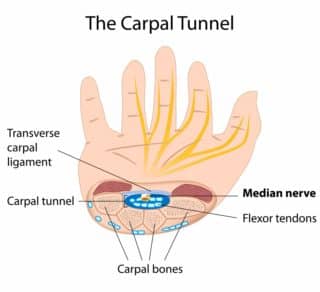INTRODUCTION TO CARPAL TUNNEL
What is the carpal tunnel?
The carpal tunnel is a narrow canal in the wrist. The bottom and sides of the tunnel are formed by a semi-circle of bones called carpal bones. A strong tissue, called Transverse Carpal ligament, forms the top of the tunnel. The median nerve and tendons pass through this narrow space. The tendons connect muscles in the forearm to bones in the hand. Conditions that narrow the carpal tunnel, cause carpal tunnel syndrome by compressing the median nerve.
Median Nerve
The median nerve runs the length of the arm, passes through the wrist (within the carpal tunnel), and ends in the hand. It controls some movement in the thumb and gives sensation to the thumb, index finger, middle finger, and half of the ring finger.
Transverse Carpal Ligament
The transverse carpal ligament is the flexible, slightly elastic cord that lies on top of the carpal tunnel at the wrist. This ligament connects the bones to each other where the wrist and palm meet.
The transverse carpal ligament may be cut during surgery for carpal tunnel syndrome. Cutting the ligament helps relieve the pressure on the median nerve, which runs through the carpal tunnel.
Pressure on the median nerve results in the symptoms of carpal tunnel syndrome. These include tingling, numbness, muscle weakness, and/or pain in the fingers, hand, or lower arm.
